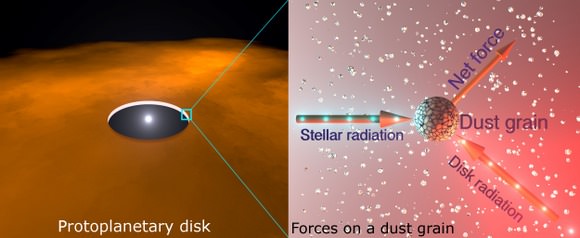Rocky planets like Earth are all believed to have begun as dust circling newly born stars, and clues about the origin of such dust comes to us in today’s meteorites and comets, as well as observations of circumstellar disks around young stars.
But mystery has shrouded the details of the evolution of dust and how it eventually comes to form larger objects. Now, two papers in the journal Nature are proposing a new mechanism to explain it.
The new mechanism hinges on heat-shocked crystalline dust grains, which somehow migrated from where they were created — presumably close to the Sun — to the outer Solar System. By implication, the same process should occur around other young stars.
A trio of past hypotheses had been proposed to explain the migration, but none of them quite fit. They included, according to physicist Dejan Vinkovic of the University of Split in Croatia, turbulent mixing, ballistic launching of particles in a dense wind created by interaction of the accretion disk with the young star’s magnetic field (called the X-wind model), and mixing mediated by transient spiral arms in marginally gravitationally unstable disks. Vinkovic is lead author on one of the Nature papers.
“The turbulent mixing requires a source of efficient turbulent viscosity and the magnetorotational instability is invoked as the most promising candidate, but large stretches of the disk are considered not sufficiently ionized to keep this instability active,” he wrote. “The X-wind model relies on the theoretical notion of magnetic field configurations in the immediate vicinity of pre-main-sequence stars and high hopes are put on future observations to resolve this predicament.”
And finally, “The spiral arms model is in the domain of discussions on whether the underlying numerics, physical approximations and assumptions about the initial conditions are realistic enough to make results plausible.”
In the other paper, Peter Abraham of the Hungarian Academy of Sciences and his colleagues find the signature of crystalline dust after a young star flared, whereas archival data showed no sign of it before the flare.
The Vinkovic paper investigates the mixing of large crystalline dust particles in the protoplanetary nebula around the young Sun.
The force produced by the light shining on an object is a well known phenomenon called radiation pressure. We do not feel it in daily lives because we are too massive for this effect to be noticeable. For very small particles, on the other hand, this force can be larger even than the gravity that keeps particles in the orbit around the star. Investigations have been focused so far only to the radiation pressure due to the starlight. The results showed that individual grains would not travel far and would be pushed deeper into the disk.
Vinkovic reports that infrared radiation arising from the dusty disk can loft grains bigger than one micrometer out of the inner disk, where they are pushed outwards by stellar radiation pressure while gliding above the disk. Grains re-enter the disk at radii where it is too cold to produce sufficient infrared radiation pressure support for a given grain size and solid density.
However, Vinkovic points out that it is not only the star, but also the disk that shines. When studying effects on protoplanetary dust grains larger than one micrometer, which is comparable to the particle size of cigarette smoke, Vinkovic has discovered that the intense infrared light from the hottest regions of the protoplanetary disk is capable of pushing such dust out of the disk. Infrared radiation is what we can feel as “heat” on our skin. Combination of radiation pressure from the star and the disk creates a net force that enables dust grains to surf along the disk surface from inner to outer regions of the disk.
The temperatures in this hot region reach around 1500 degrees Kelvin (2200 degrees Fahrenheit), enough to vaporize solid dust particles or to alter their physical and chemical structure. The mechanism that Vinkovic describes in his paper would transfer such altered dust particles to colder disk regions away from the star. This can explain why comets contain a puzzling combination of ices and particles altered at high temperatures. Astronomers have been perplexed by this mixture, since comets form in cold disk regions out of frozen substances like water, carbon dioxide or methane. Rocky dust particles that end up mixed with ices are therefore expected to never experience high temperatures.
In an editorial accompanying the studies, University of Missouri astrophysicist Aigen Li wrote that the origin of crystalline silicates in comets “has been a matter of debate since their first detection 20 years ago.”
While Li touts promise in the new theory, “It would be interesting to see whether other mechanisms such as turbulent mixing and the ‘X-wind’ model would effectively carry submicrometre grains, which are efficient mid-IR emitters, outwards and incorporate them into comets,” he wrote. “It is also possible that some — but not all — crystalline silicates are made in situ in cometary comae.”
Source: Vinkovic’s press release. Watch a short animation showing how the newly proposed mechanism of dust movement works.


Are there observational tests for this?
regarding the line “Infrared radiation is what we can feel as ‘heat’ on our skin”–this is inaccurate and related to a common misconception. When our skin absorbs visible light, we also feel that as heat; infrared light doesn’t equate to heat.
this misconception was in the original press release; the physicist should have known better, but perhaps someone else wrote the press release?
Dunno without reading the papers. But I suppose that if size and disk sorting effects are in place (as regards the disk, the conditions at the place of origination) you would expect to see some certain size vs material distributions where you collect the material.